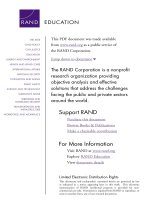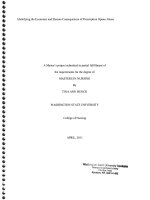The function of DTRAF1 in drosophila neuroblast asymmetric cell division
Bạn đang xem bản rút gọn của tài liệu. Xem và tải ngay bản đầy đủ của tài liệu tại đây (5.12 MB, 145 trang )
THE FUNCTION OF DTRAF1 IN DROSOPHILA
NEUROBLAST ASYMMETRIC CELL DIVISION
WANG HUASHAN
NATIONAL UNIVERSITY OF SINGAPORE
2006
THE FUNCTION OF DTRAF1 IN DROSOPHILA NEUROBLAST
ASYMMETRIC CELL DIVISION
WANG HUASHAN
A THESIS SUBMITTED
FOR THE DEGREE OF DOCTOR OF PHILOSOPHY
INSTITUTE OF MOLECULAR AND CELL BIOLOGY
DEPARTMENT OF ANATOMY
NATIONAL UNIVERSITY OF SINGAPORE
2006
i
ACKNOWLEDGEMENTS
Firstly, I would like to thank my parents, sister, wife and all the relatives I love
and love me for their support, love and encouragement throughout all these years.
Secondly, I would like to thank A/P Xiaohang Yang and Prof. William Chia, for their
taking me as a student in the lab, their continuous guidance and supervision throughout
these years. Thirdly, I would like to thank the members of my post-graduate committee,
A/P Mingjie Cai, A/P Li Benjamin and Dr. Sami Bahri, for their invaluable discussions
and suggestions pertaining to the project. Fourthly, I would like to thank the past and
present members of BC/YXH lab and LSC lab, especially Dr. Yu Cai and Dr. Chanhe
Chen, for encouraging discussions, suggestions, assistance and all the happy time spent
together.
In addition, I would like to acknowledge the contributions of the various
administrative and technical staffs in IMCB, especially Mohd Sharudin bin for his help
on the generation of antibodies.
All to my grandmother, you are always in my heart.
4
th
April, 2006
Wang Huashan
ii
TABLE OF CONTENTS
ACKNOWLEDGEMENTS i
TABLE OF CONTENTS ii
ABBREVATIONS vi
SUMMARY xiii
Chapter1. Introduction 1
1. Asymmetric cell division in C. elegans 2
1.1 The establishment of the anterior-posterior (AP) body axis 3
1.2 The formation of cortical domains 6
1.3 Cortical domains are required for asymmetric events
in the early embryo 8
1.3.1 The control of spindle positioning during the first
mitotic division of the C. elegans zygote 8
1.3.2 The polarized distribution of cell-fate determinants
along the AP axis 10
2. Asymmetric cell division in Drosophila melanogaster 13
2.1 Asymmetric division of neuroblasts in the Drosophila
central nervous system 13
2.1.1 Establishment of apical–basal NB polarity 15
2.1.2 Asymmetric localization of cell fate determinants and
iii
the control of spindle orientation in NBs 17
2.1.3 Cell size regulation during NB divisions 22
2.1.4 Asymmetric localization and function of cell-fate determinants 25
2.1.5 Telophase rescue and Insc-independent mechanism 28
2.2 Asymmetric division of sense organ precursor cells in
the Drosophila peripheral nervous system 30
2.3 Establishing polarity in Drosophila germline cyst during oogenesis 33
3. The cell polarity and asymmetric cell division in vertebrate 37
3.1 Asymmetric cell divisions during neurogenesis in developing
vertebrate central nervous system 37
3.2 Establishing cell polarity in mammalian epithelial cells 45
4. TNF pathway 48
4.1. TNF 49
4.2. TNF receptor 50
4.3. Tumor necrosis factor receptor associated factor 53
4.3.1. TRAF family members 53
4.3.2. Domains and structures of TRAF proteins 54
4.3.3. Recruitment of TRAFs to signaling receptors 55
4.3.4. TRAF-activated signal transduction pathways 57
4.3.4.1. TRAF-mediated activation of NF-κB 57
4.3.4.2. TRAF-mediated activation of JNK 58
iv
Chapter2. Materials and Methods 60
2.1 Molecular work 61
2.1.1 Recombinant DNA methods 61
2.1.2 Strains and growth conditions 61
2.1.3 Cloning strategy 62
2.1.4 Transformation of E. coli cells 63
2.1.5 Plasmid DNA preparation 64
2.1.6 Site-directed mutagenesis 68
2.1.7 PCR reaction 69
2.1.8 Protein analysis 70
2.1.9 Generation of polyclonal antibody 70
2.1.10 In vitro protein binding assay 72
2.2 Fly genetics 72
2.2.1 Embryo fixing 73
2.2.2 Whole embryo RNA in-situ hybridization 75
2.2.3 Embryo antibody staining 77
2.2.4 Double-stranded RNA interference 78
2.2.5 Mobilization of EP-element 79
2.2.6 Inverse PCR 80
2.2.7 Fly genomic DNA extraction 81
2.2.8 Single fly DNA extraction 82
2.2.9 Southern blot for the detection of deletion in fly genome 82
2.2.10 Germ line transformation 84
v
2.2.11 Ectopic expression 85
2.2.12 Antibodies 85
2.2.13 Confocal analysis and image processing 85
Chapter3. Result and discussion 87
3.1 Background 88
3.2 Results 92
3.2.1 DTRAF1 is apically localized in mitotic NBs 92
3.2.2 Cell fate determinants Mira/Pros and Pon/Numb are normal in
DTRAF1 mutant NBs 96
3.2.3 DTRAF1 is required for Mira/Pros normal crescent formation
at metaphase in insc NBs 97
3.2.4 Mira telophase rescue is compromised in the absence
of DTRAF1 99
3.2.5 Apical localization of DTRAF1 is required for Mira/Pros
telophase rescue 102
3.2.6 Egr, Drosophila homolog of TNF, is involved in Mira
telophase rescue 104
3.2.7 DTRAF1 interacts with Baz in vitro 107
3.3 Discussion 107
Reference 114
Appendix 131
vi
ABBREVIATIONS
a.a. amino acid
APC adenomatous polyposis coli protein
Baz bazooka
bp base pair
BSA bovine serum albumin
CIP calf intestinal phosphatase
Crb crumbs
CRD cysteine-rich domain
C-terminus carboxy-terminus
DaPKC Drosophila atypical protein kinase C
DASK Drosophila apoptosis signal-regulating kinase
DD death domain
DIAP Drosophila inhibitor-of-apoptosis protein 1
DISC death-inducing signaling complex
DNA deoxyribonucleic acid
DLG discs Large
DmPar6 Drosophila melanogaster Par6
E-APC epithelial-cell-enriched APC
ECM extracelluar matrix
E.coli Esherichia coli
EDTA ethylenediamine tetraacetic acid
Esg escargot
F-actin filamentous actin
FADD fas associated death domain
GDI guanine-nucleotide dissociation inhibitor
GFP green fluorescent protein
GJ gap junction
GMC ganglion mother cell
vii
GST glutathione S-transferase
Gαi α subunit of heterotrimeric G protein
Gβ13F β subunit of heterotrimeric G protein on chromosome 13F
Hid head involution defective
IgG immunoglobin G
Insc inscuteable
IP immunoprecipitation
IPTG isopropyl-1-thio-β-D-galactopyranoside
Kb kilobases
Lgl lethal giant larvae
LT lymphotoxin
Mira miranda
MTOC microtubule-organizing center
MZ marginal zone
MAGUK membrane-associated guanylate kinase
N-terminus amino-terminus
PAGE polyacrylamide gel electrophoresis
PCR polymerase chain reaction
PDZ domain PSD-95, discs large, ZO-1 domain
Pins partner of Inscuteable
Pon partner of Numb
Pros prospero
Rpr reaper
Scrib scribbled
Sna snail
SPCC sperm pronucleus/centrosomal complex
Std stardust
TIM TRAF-interacting motif
TIR Toll/IL-1R homology region
TLR Toll-like receptor
viii
TNF tumor necrosis factor
TNFR tumor necrosis factor receptor
TRAF tumor necrosis factor associated factors
TRADD TNFR-associated death domain
WT wild-type
Wor worniu
ZA zonula adherens
Summary
In the past decade, Drosophila melanogaster has been proven to be an excellent
model for studying the mechanisms of asymmetric cell division, which generates cell
diversity during animal development. In this thesis I analyze telophase rescue in detail in
insc mutant NBs and report that DTRAF1 is specifically involved in telophase rescue for
the cell fate determinant Mira/Pros but not for Pon/Numb. DTRAF1 is localized to the
apical cortex of mitotic NBs and interacts with Baz in vitro. I demonstrate that telophase
rescue is compromised when DTRAF1 is removed or delocalized from the apical cortex
in various genetic backgrounds. I also show that Eiger, the Drosophila homolog of TNF,
is required for telophase rescue. My data provide the first evidence that in Drosophila
embryonic CNS, the TNF signal pathway is involved in Mira/Pros telophase rescue.
Chapter1 Introduction
1
Chapter 1
Introduction
Chapter1 Introduction
2
There are two types of cell division: symmetric and asymmetric. The
symmetric cell division produces two identical daughter cells that acquire the
same developmental fate. The main purpose of symmetric divisions is
proliferation, i.e. expansion of cell populations. The asymmetric cell division
gives rise to two daughter cells with different developmental fates and generates
cell diversity from bacteria to mammals. The asymmetric cell division can be
achieved by either intrinsic or extrinsic mechanisms. Intrinsic mechanism involves
the preferential segregation of cell fate determinants into one of two daughter cells
during mitosis, which requires a highly specialized machinery that mediates
correct spindle orientation and coordinates other key events in this process to
ensure the faithful segregation of determinants. Extrinsic mechanism involves
cell–cell communication. In metazoans, interactions between daughter cells or
between a daughter cell and other nearby cells could specify daughter cell fate.
Recent studies have indicated that a combination of intrinsic and extrinsic
mechanisms specify distinct daughter cell fates during asymmetric cell divisions. I
will focus my introduction on the asymmetric cell divisions that occur during the
early divisions of Caenorhabditis elegans embryos and the development of
Drosophila embryonic central nervous system.
1. Asymmetric cell division in C. elegans
Caenorhabditis elegans provides an excellent model for the understanding
the mechanism of asymmetric cell division, which generates cell type diversity
during animal development (Figure1). The one-cell Caenorhabditis elegans
embryo divides asymmetrically to produce one large and one small blastomere
with different cell fates (Cowan & Hyman, 2004, review). Three steps are
Chapter1 Introduction
3
required for this asymmetric cell division. First, a polarity cue determines the
position of the cell axis. Shortly after fertilization, the sperm pronucleus and its
associated centrosomal asters provide a cue to establish the anterior-posterior (AP)
body axis. Next, this polarity cue triggers the formation of cortical domains,
which consist of PAR proteins: an anterior domain defined by the presence of a
complex of PAR-3, PAR-6, and an atypical protein kinase C, and a posterior
domain defined by PAR-1 and PAR-2. Finally, these cortical domains are required
for the first asymmetric mitotic division including a posterior displacement of the
spindle and the differential segregation of cell-fate determinants to the anterior
and posterior daughters (Schneider & Bowerman, 2003).
1.1 The establishment of the anterior-posterior (AP) body axis
About 30 minutes after fertilization, the sperm pronucleus and its
associated centrosomes generate a cytoplasmic flux that pushes this sperm
pronucleus/centrosomal complex (SPCC) toward one pole (Hird and White, 1993;
Goldstein and Hird, 1996). The oocyte pronucleus migrates during maturation
toward the pole opposite to SPCC. Upon reaching a pole, the oblong shape of the
zygote apparently suffices to maintain the polar localization, and the SPCC
becomes closely apposed to the cell cortex. Two centrosomes, produced by
duplication of the sperm-donated centriole pair, are positioned between the
pronucleus and cell cortex. Preceding this close apposition, transient membrane
invaginations occur throughout the surface of the zygote. Subsequently, a local
cessation of cortical contractile activity appears directly over the SPCC. This
smooth cortical surface rapidly expands toward the opposite pole, culminating in a
Chapter1 Introduction
4
deep invagination of the plasma membrane, called the pseudocleavage furrow, at
the boundary of the smooth and contractile surfaces.
The morphological changes associated with the arrival of SPCC at one
pole reflect the establishment of the AP axis, the first body axis to form in C.
elegans. Several investigations indicate that the sperm pronucleus–associated
centrosomes are responsible for specifying the posterior pole and hence the AP
axis. First, the pole occupied by SPCC always becomes the posterior pole
(Albertson, 1984; Goldstein & Hird, 1996). Furthermore, mutants in which
centrosome maturation is delayed or absent fail to establish a posterior pole, and
mutant sperms that are anucleate but retain a centriole pair can fertilize oocytes
and establish an AP axis. Finally, in mutant embryos arrested at the metaphase of
meiosis I due to the loss of APC function, the sperm-donated centrioles never
mature and do not specify a posterior pole. In the absence of centrosomes, the
Figure 1. Cell polarity in the C. elegans zygote. The cell cortex of the zygote is
divided into distinct anterior (red) and posterior (green) domains. The mitotic
spindle is positioned closer to the posterior pole, which results in the
generation of a larger anterior and a smaller posterior cell after division.
GPR-1/2
PAR-3
PAR-6
PKC-3
PAR-1
PAR-2
Anterior Posterior
Chapter1 Introduction
5
meiotic spindle seems to establish some posterior character at its pole and
influence the cortical polarity through the plus end contact with the cell cortex.
But the meiotic spindle lacking centrioles can only partially and transiently
specify a posterior pole because the spindle does not generate a cytoplasmic flux
and the cytoplasmic ribonucleoprotein complexes called P granules remain evenly
distributed throughout the cytoplasm (Yang et al., 2003).
It appears that the centrosomal cue specifies the posterior pole through its
influence on the cortical microfilament cytoskeleton. The cortical accumulation of
microfilaments requirs the formin homology protein CYK-1 and the profilin PFN-
1. Chemical disruption of microfilaments with cytochalasin D treatment, or
genetic disruption by the depletion of PFN-1, eliminates contractile activity
throughout the cortex during meiosis, and abolishes both the cytoplasmic flux
normally directed by the SPCC and the establishment of an AP axis (Severson et
al., 2002 ). All these may suggest two possible models for axis formation. The
maturing sperm pronucleus-associated centrosomes may destabilize overlying
cortical microfilaments after the completion of meiosis. As a result, the contractile
activity generated by NMY-2 and MLC-4 can pull microfilaments away from the
point of weakening, promoting a contraction of the entire network toward the
opposite pole. This contraction of the microfilament network toward one pole may
account for the cortical movement of cytoplasm away from, and internal
cytoplasm toward, the SPCC. It is also possible that cortical microfilaments are
influenced by expansion of the area in which astral microtubule plus-ends contact
the cell cortex, as sperm asters mature and nucleate more and longer microtubules
(Wallenfang & Seydoux, 2000).
Chapter1 Introduction
6
1.2 The formation of cortical domains
The establishment of an AP axis after fertilization results in the first
mitotic division of the zygote being asymmetric. This unequal division produces a
larger anterior daughter, AB, which divides before its smaller posterior sister P1.
AB divides equally, with its mitotic spindle perpendicular to the AP axis, whereas
P1 divides asymmetrically, with its mitotic spindle aligned with the AP axis.
Genetic screens have identified a group of conserved, cortically localized
regulators called the PAR (partitioning-defective) proteins that are required for
these AP asymmetries. In most par mutant embryos, the first mitotic division is
equal, and the two daughters divide synchronously, with mitotic spindles often
aligned along the same axis (Rose & Kemphues, 1998). Among six of them, PAR-
3 with three PDZ domains and PAR-6 with a single PDZ domain, form a complex
with an atypical protein kinase C (PKC-3) (Etemad-Moghadam et al., 1995; Watts
et al., 1996; Tabuse et al., 1998). This complex becomes restricted to the anterior
cortex of the one-cell zygote after the SPCC-induced polarization of the AP axis.
The RING-finger protein PAR-2 and the serine/threonine kinase PAR-1 become
restricted to the posterior cortex (Levitan et al., 1994; Guo & Kemphues, 1995;
Boyd et al., 1996). The boundaries of these two cortical domains abut roughly
midway along the AP axis. In the absence of any one of the anterior group
proteins, the other two members of the complex are lost from the cortex, and the
posterior cortical proteins PAR-1 and PAR-2 spread toward the anterior pole. In
the absence of PAR-2, PAR-1 is lost from the cortex and the anterior complex
spreads toward the posterior. PAR-1 appears to be downstream of PAR-2, as the
polarized distributions of PAR-2 and the anterior complex are not affected by the
absence of PAR-1. The other two PAR proteins, the serine/threonine kinase PAR-
Chapter1 Introduction
7
4 and the 14-3-3 protein PAR-5, are uniformly distributed throughout the cortex in
early embryonic cells. In the absence of PAR-5, the anterior and posterior cortical
domains are no longer mutually exclusive and overlap.
The PAR protein asymmetry is established by the SPCC cue (Cuenca et al.,
2003). Before polarization of the zygote, the anterior and posterior PAR proteins
are uniformly distributed around the cortex, and the sperm cue appears to result in
an increase in cortical levels of the PAR proteins that then organize and maintain
mutually exclusive domains and their polarized distribution. The smooth patch of
cortex over the SPCC still appears in all par mutant embryos, suggesting that this
initial step in polarization is upstream of the PAR proteins. Although the small
GTPase CDC-42 is not required for the initial establishment of an anterior PAR
domain, it is required to maintain this polarized distribution and to prevent overlap
of the anterior and posterior PAR domains. After depletion of CDC-42, PAR-2
does not respond to the SPCC and remains present throughout the cortex. The
final position of the anterior and posterior PAR boundary depends at least in part
on a feedback loop involving PAR-1 and two nearly identical and largely
redundant cytoplasmic CCCH finger proteins called MEX-5 and MEX-6 (Cuenca
et al., 2003). In par-1 mutant embryos, the PAR-2 domain expands more rapidly
and advances further toward the anterior pole, with a corresponding reduction of
the anterior PAR domain and a more anterior position of the pseudocleavage
furrow. In contrast, depletion of MEX-5 and MEX-6 reduces the expansion of
PAR-2, resulting in a more extensive anterior PAR domain and a more posterior
pseudocleavage furrow. Moreover, depletion of MEX-5 and MEX-6 in par-1
mutant embryos suppresses the overexpansion of PAR-2. In a wild-type zygote,
MEX-5/6 levels initially are high throughout the cytoplasm when axis formation
Chapter1 Introduction
8
begins, but decrease in the posterior cytoplasm as PAR-1 accumulates at the
posterior cortex, and this reduction requires PAR-1 (Cuenca et al., 2000; Schubert
et al., 2000). Thus the accumulation of PAR-1 may eventually deplete MEX-5/6
sufficiently to limit expansion of the posterior domain.
1.3 Cortical domains are required for asymmetric events in the early
embryo
The PAR proteins are required for most AP asymmetries in the early
embryo, which include a posterior displacement of the first mitotic spindle and the
polarized distribution of cell-fate determinants along the AP axis (Rose &
Kemphues, 1998). Recent studies show that distinct pathways operate downstream
of the PAR proteins to control these two processes.
1.3.1 The control of spindle positioning during the first mitotic
division of the C. elegans zygote.
After the SPCC establishes a posterior pole, the sperm pronucleus and the
maternal pronucleus will meet near posterior pole and form a complex. This
complex then rotates such that the centrosomes align with the AP axis. At the
same time, the complex will move toward the center of the zygote. The rotation
and centration require dynein, dynactin, and long astral microtubules. When
dynein and dynactin are partially depleted, pronuclear migration can occur but
rotation and centration often fail, leaving the pronuclear/centrosome complex in
the posterior. Similarly, if microtubules are partially destabilized by agents such
as nocodazole, centration and rotation fail to occur (Hyman & White, 1987). It
seems that a protein called LET-99 is required for the regulation of cortical forces
Chapter1 Introduction
9
on astral microtubules. In let-99 mutants, the nuclear-centrosome complex swings
back and forth and fails to centrate. LET-99 appears to act downstream of the
PAR proteins because the positioning of LET-99 requires PAR-2 and PAR-3,
while PAR-2 and PAR-3 are localized normally in let-99 mutants.
After rotation and centration, the spindle moves toward the posterior pole
with greater forces applied from the posterior cortex as it elongates during
anaphase. The PAR proteins are required to generate the asymmetry in cortical
pulling forces (Grill et al., 2001). In par-2 and par-3 mutants, the first mitotic
spindle remains centrally positioned, producing daughters of equal size. PAR-3
decreases the cortical forces at the anterior pole in a wild-type embryo, while
PAR-2 simply restricts the function of PAR-3 to the anterior. Recent studies
reveal that the PAR proteins influence the magnitude of cortical forces through
two redundant heterotrimeric G protein alpha subunits, GOA-1 and GPA-16. After
depletion of both Gα subunits, the first mitotic spindle remains centrally
positioned, both centrosomes remain spherical, and neither pole exhibits rocking
motions. Furthermore, GOA-1 and GPA-16 are required for most if not all of the
cortical forces applied to centrosomes (Gotta et al., 2001; Colombo et al., 2003).
Though required for the cortical forces, GOA-1 and GPA-16 do not appear
to account for the asymmetry in force since GOA-1 is uniformly distributed
throughout the cortex of early embryonic cells and does not show any asymmetric
localization. The generation of asymmetric cortical forces may be regulated by
two nearly identical proteins called GPR-1 and GPR-2 that contain Goloco motifs
(Colombo et al., 2003). These two proteins appear to provide receptor-
independent activation of Gα proteins to influence mitotic spindle positioning.
Depletion of GPR-1/2 results in a phenotype identical to that of GOA-1/GPA-16
Chapter1 Introduction
10
depleted embryos. RIC-8, a putative guanine nucleotide exchange factor for Gα,
interacts genetically with GOA-1 to cause spindle position defects at the 2-cell
stage, suggesting that RIC-8 also activates GOA-1 (Miller & Rand, 2000). A
coiled coil protein called LIN-5 is involved in recruiting GPR-1/2 and GOA-
1/GPA-16 to the cortex and to spindle poles. GPR-1/2 may positively regulate
forces at the posterior by acting through GOA-1 and GPA-16.
The finding that pulling forces act on spindle poles suggests that the force
generating machinery is present at the cell cortex and interacts with microtubule
plus ends that contact the cortex (Grill et al., 2001). One dynein heavy chain and a
dynactin subunit are involved in assembly and positioning of the first mitotic
spindle, hence the asymmetry in cortical forces displaces the first mitotic spindle
toward the posterior pole. These results indicate that a PAR-dependent asymmetry
in pulling forces at each pole is generated by the decreased stability of
microtubules at the posterior pole and the capture of the shortening plus ends by a
cortically anchored complex. More recently, experiments using Latrunculin A
exposure during pronuclear migration have suggested that microfilaments are
required for the spindle rotation, even in the absence of normal cell polarity.
1.3.2 Polarized distribution of cell-fate determinants along the AP axis
The cortical PAR proteins are required for the asymmetric segregation of
cytoplasmic cell-fate determinates along AP axis in the first mitotic division.
PAR-1 is required for the asymmetric distribution of two partially redundant
cytoplasmic proteins called MEX-5 and MEX-6 (Boyd et al., 1996; Guo &
Kemphues, 1995; Schubert et al., 2000). PAR-1 restricts MEX-5 and MEX-6 to
the anterior cytoplasm, with the posterior MEX-5/6 boundary in the cytoplasm
Chapter1 Introduction
11
corresponding precisely to the anterior boundary of PAR-1 at the cortex. In par-1
mutants, MEX-5 and MEX-6 are present at high levels throughout the cytoplasm,
whereas PAR-1 distribution is unaffected in mex-5, mex-6 double mutants. MEX-
5 and MEX-6 in turn are required to restrict a group of proteins that include PIE-1,
POS-1 and MEX-1 to the posterior cytoplasm of the zygote. In mex-5; mex-6
mutants, PIE-1, POS-1, and MEX-1 are present throughout the cytoplasm,
whereas MEX-5 and MEX-6 are unaffected in mutants lacking PIE-1, POS-1, or
MEX-1. Thus a hierarchy of regulation converts the cortical polarity of the PAR
proteins into a complementary pattern of cytoplasmic protein polarity. Eliminating
any one of these proteins results in abnormal cell-fate patterning. For example,
PIE-1 appears to specify germline fate, and in pie-1 mutants germline is not
produced and excess pharynx and intestine are made (Mello et al., 1992, 1996;
Seydoux et al., 1996).
Several studies have suggested that the distribution of cell-fate
determinants is regulated by protein stability differences at each pole, protein
translocation through the cytoplasm and the regulation at translational level. The
posterior cortex localization of cytoplasmic ribonucleoprotein, P granules,
involves both the movement of P granules toward the posterior and the instability
and eventual degradation of P granules that fail to move to the posterior.
Furthermore, the normal distribution of PIE-1 in embryonic cells requires the
degradation of PIE-1 left in the anterior daughter (Reese et al., 2000). The
ubiquitin-mediated targeting of PIE-1 and other posterior CCCH finger proteins
for proteosome-mediated degradation in anterior daughter cells is responsible, in
part, for the asymmetric cytoplasmic distributions of these proteins. This
Chapter1 Introduction
12
degradation also requires the presence of MEX-5 and MEX-6, but how these two
proteins contribute to the process is not known.
Another mechanism regulating the asymmetric distribution of
developmental regulators is the spatial regulation of translation since most of the
maternally expressed mRNAs that encode determinants of cell fate are uniformly
distributed throughout early embryonic cells in C. elegans. For example, the
Notch receptor homolog GLP-1 is detected at high levels only in anterior cells
(Evans et al., 1994). The combinatorial regulation by trans-acting factors provides
both spatial and temporal regulation of translation in anterior and posterior
embryonic cells. The CCCH protein POS-1 and an RRM (RNA Recognition Motif)
protein called SPN-4 bind different sequences in the 3’ UTR of glp-1 mRNA,
called the spatial control region (SCR) and temporal control region (TCR),
respectively. POS-1 is required to repress the translation of glp-1 mRNA in
posterior cells, while SPN-4 is required to facilitate translation in the anterior. The
STAR/KH domain protein GLD-1 also binds to the same SCR of glp-1 mRNA
and represses glp-1 translation in the posterior (Marin & Evans, 2003). Thus,
GLP-1 localization may involve both localization of repressors to the posterior
and de-repression in the anterior. Thus a sequence of protein stability and
translational regulation are in part responsible for converting the polarity first
established by the sperm pronucleus–associated cue and the PAR proteins into
patterns of cell-fate potential inherited by early embryonic cells.
Chapter1 Introduction
13
2. Asymmetric cell division in Drosophila melanogaster
Drosophila melanogaster provides another excellent model for
understanding the mechanisms behind asymmetric cell division during animal
development. The complexity of neuronal cell types in the central nervous system
(CNS) of Drosophila is generated by the asymmetric cell division of stem-cell-
like precursors, neuroblasts (NBs), which are derived from the ventral and
procephalic neuroectoderm. At least three types of NBs make up the CNS: the
first is the ventral NBs, which enlarge and delaminate from the neuroectoderm
and divide repeatedly to ‘bud off’ smaller ganglion mother cells (GMCs). Each
GMC divides terminally to produce a pair of neurons or glia (Goodman and Doe,
1993), which form the ventral cord of the CNS. The second type is the
procephalic ectodermal cells (domain 9 cells, Campos-Ortega & Hartenstein, 1965;
Foe, 1989), which divide asymmetrically along the apical/basal axis without
delaminating. The domain 9 cells behave exactly like ventral NBs and divide
asymmetrically to produce two daughters with different cell size. The neurons
derived from domain 9 cells form the brain lobes. The third type comprises the
MP2 cell, which is formed just like a ventral NB but only divides asymmetrically
once to produce a basal neuron dMP2, and an apical neuron vMP2, each with
different axonal projections and patterns of gene expression (Spana et al., 1995).
2.1 Asymmetric division of NBs in the Drosophila central nervous system
CNS in Drosophila develops from the NB, the precursor cell with stem
cell-like properties (Figure 2). The NBs delaminate basally as individual cells
from the neuroectodermal epithelium. The decision whether to adopt a neuroblast
versus epidermal fate involves cell- cell communication mediated by proneural
Chapter1 Introduction
14
genes and neurogenic genes. Shortly after delamination, NBs start to divide
asymmetrically to produce one big and one small cell in each division. The larger
apical daughter cell remains as NB and continues to divide in a stem-cell-like
fashion, while the smaller basal daughter is the ganglion mother cell (GMC) and
divides one more time to generate two neurons or glial cells (Campos-Ortega,
1993; Goodman & Doe, 1993). During the NB division, the mitotic spindle is
parallel to the epithelium at prophase. By metaphase it rotates 90° and becomes
perpendicular to epithelium. As the consequence, the GMC is always pinched off
at the basal side of the NB. Several proteins and mRNAs that serve as cell fate
determinants are localized to the basal pole of the NB during mitosis and are
segregated exclusively to the GMC during cytokinesis. One of these basal proteins,
the homeobox transcription factor Prospero (Pros), is required for the GMC-
specific cell fate. In addition, Pros suppresses transcription of multiple cell-cycle
Apical
Basal
Insc, Baz,
DmPar-6, aPKC
Pins, Gαi, Loco
Mira, Pros,
Numb, Pon
Figure 2. Asymmetric cell division of Drosophila neuroblasts. During
metaphase, Pins, GαI, Insc, Baz, DaPKC and DmPar-6 localize to the apical
cortex and control the spindle orientation and the basal localization of cell fate
determinants including Mira, Pros, Numb and Pon. After anaphase, the basal
protein complex is segregated to the small cell, the future GMC.
Chapter1 Introduction
15
regulators, leading to exit from the mitotic cycle and allowing terminal
differentiation of neurons and glia cells after one final cell division (Doe et al.,
1991; Li & Vaessin, 2000). Without Pros, the small basal cell will not become the
GMC. In the following sections I will focus on the establishment of apical-basal
polarity in NBs, the polarized localization of cell fate determinants and the
mechanism for the different cell sizes between NB and GMC.
2.1.1. Establishment of apical–basal NB polarity
The establishment of cell polarity along the apical–basal axis in
Drosophila NBs is the prerequisite for proper spindle orientation and asymmetric
segregation of cell fate determinants. Prior to delamination and its first division,
each NB of the ventral neuroectoderm region (VNR) is integrated into the
neuroectodermal epithelium and is connected to adjacent cells by the zonula
adherens (ZA), a belt like adherens junction (AJ) encircling the apex of the cells.
Polarity is inherited when NBs become specified in the polarized neuroectoderm
and delaminate basally from the epithelium layer. Proteins of the PAR/aPKC
complex [Bazooka (Baz); atypical protein kinase C (DaPKC); PAR-6], which are
concentrated to the apical side to the adherens junctions in the neuroectoderm, are
found in a stalk that extends into the epithelial layer and localized to the apical
cell cortex of dividing NBs after the NB has fully delaminated and the stalk has
been retracted (Ohno, 2001; Petronczki and Knoblich, 2001; Wodarz, 2002).
Mutations in the genes encoding components of the PAR/aPKC complex lead to
loss of apical–basal polarity in both epithelia and NBs, suggesting that NBs inherit
the cue for the apical-basal polarity from the overlying epithelium layer.
However, NB polarity is not absolutely dependent on an intact









